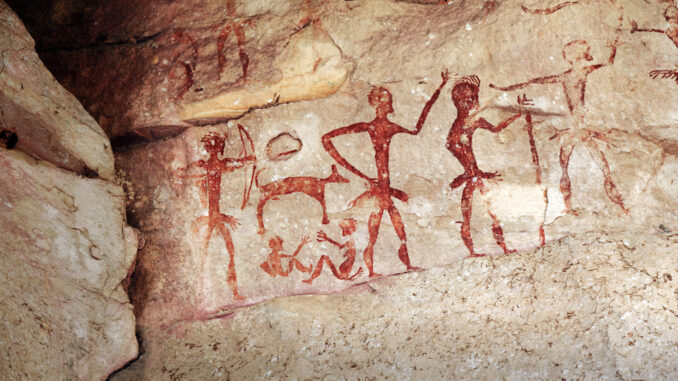
Only an anthropologist would treasure millennia-old human feces found in dry caves.
Just ask Dr. Meradeth Snow, a University of Montana researcher and co-chair of UM’s Department of Anthropology. She is part of an international team, led by the Harvard Medical School-affiliated Joslin Diabetes Center, that used human “paleofeces” to discover that ancient people had far different microorganisms living in their guts than we do in modern times.
Snow said studying the gut microbes found in the ancient fecal material may offer clues to combat diseases like diabetes that afflict people living in today’s industrialized societies.
“We need to have some specific microorganisms in the right ratios for our bodies to operate effectively,” Snow said.
“It’s a symbiotic relationship. But when we study people today – anywhere on the planet – we know that their gut microbiomes have been influenced by our modern world, either through diet, chemicals, antibiotics or a host of other things. So understanding what the gut microbiome looked like before industrialization happened helps us understand what’s different in today’s guts.”
This new research was published May 12 in the prestigious journal Nature. The article is titled “Reconstruction of ancient microbial genomes from the human gut.” Snow and UM graduate student Tre Blohm are among the 28 authors of the piece, who hail from institutions around the globe.
Snow said the feces they studied came from dry caves in Utah and northern Mexico. So what does the 1,000-year-old human excrement look like?
“The caves these paleofeces came from are known for their amazing preservation,” she said. “Things that would normally degrade over time look almost brand new. So the paleofeces looked like, well, feces that are very dried out.”
Snow and Blohm worked hands-on with the precious specimens, suiting up in a clean-room laboratory at UM to avoid contamination from the environment or any other microorganisms – not an easy task when the tiny creatures are literally in and on everything. They would carefully collect a small portion that allowed them to separate out the DNA from the rest of the material. Blohm then used the sequenced DNA to confirm the paleofeces came from ancient people.
The senior author of the Nature paper is Aleksandar Kostic of the Joslin Diabetes Center. In previous studies of children living in Finland and Russia, he and his partners revealed that kids living in industrialized areas – who are much more likely to develop Type 1 diabetes than those in non-industrialized areas – have very different gut microbiomes.
“We were able to identify specific microbes and microbial products that we believe hampered a proper immune education in early life,” Kostic said. “And this leads later on to higher incidents of not just Type 1 diabetes, but other autoimmune and allergic diseases.”
Kostic wanted to find a healthy human microbiome without the effects of modern industrialization, but he became convinced that couldn’t happen with any modern living people, pointing out that even tribes in the remote Amazon are contracting COVID-19.
So that’s when the researchers turned to samples collected from arid environments in the North American Southwest. The DNA from eight well-preserved ancient gut samples were compared with the DNA of 789 modern samples. Half the modern samples came from people eating diets where most food comes from grocery stores, and the remainder came from people consuming non-industrialized foods mostly grown in their own communities.
The differences between microbiome populations were striking. For instance, a bacterium known as Treponema succinifaciens wasn’t in a single “industrialized” population’s microbiome the team analyzed, but it was in every single one of the eight ancient microbiomes. But researchers found the ancient microbiomes did match up more closely with modern non-industrialized population’s microbiomes.
The scientists found that almost 40% of the ancient microbial species had never been seen before. Kostic speculated on what caused the high genetic variability:
“In ancient cultures, the foods you’re eating are very diverse and can support a more eclectic collection of microbes,” Kostic said. “But as you move toward industrialization and more of a grocery-store diet, you lose a lot of nutrients that help to support a more diverse microbiome.”
Moreover, the ancient microbial populations incorporated fewer genes related to antibiotic resistance. The ancient samples also featured lower numbers of genes that produce proteins that degrade the intestinal mucus layer, which then can produce inflammation that is linked with various diseases.
Snow and several coauthors and museum collection managers also led a project to ensure the inclusion of Indigenous perspectives in the research.
“This was a really vital part of the work that had to accompany this kind of research,” she said. “Initially, we sent out multiple letters and emails and called the tribal historic preservation officers of the all the recognized tribes in the Southwest region. Then we met with anyone who was interested, doing short presentations and answering questions and following up with interested parties.
The feedback we received was noteworthy, in that we needed to keep in mind that these paleofeces have to ties their ancestors, and we needed to be – and hopefully have been – as respectful as possible about them,” she said.
“There is a long history of misuse of genetic data from Indigenous communities, and we strove to be mindful of this by meeting and speaking with as many people as possible to obtain their insights and perspectives. We hope that this will set a precedent for us as scientists and others working with genetic material from Indigenous communities past and present.”
Snow said the research overall revealed some fascinating things.
“The biggest finding is that the gut microbiome in the past was far more diverse than today – and this loss of diversity is something we are seeing in humans around the world,” she said. “It’s really important that we learn more about these little microorganisms and what they do for us in our symbiotic relationships.
“In the end, it could make us all healthier.”
Source: THE UNIVERSITY OF MONTANA

